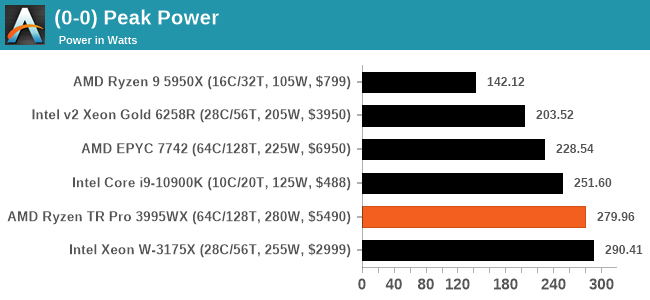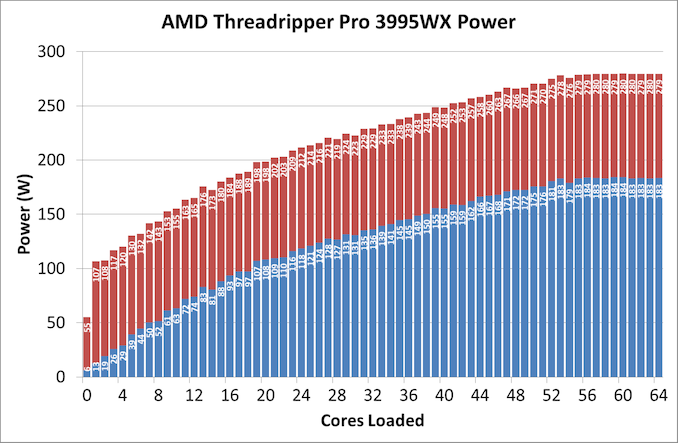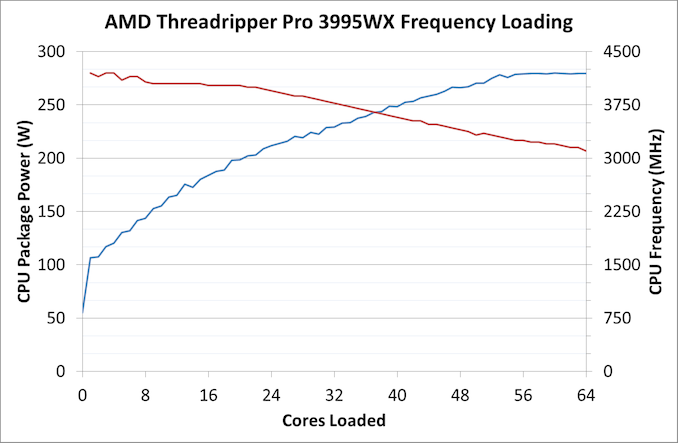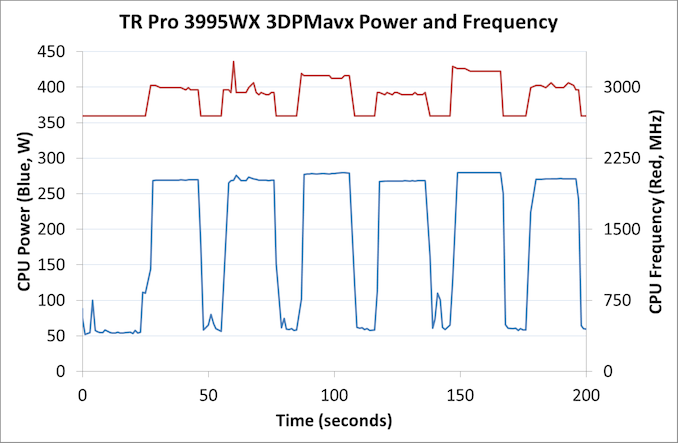64 Cores of Rendering Madness: The AMD Threadripper Pro 3995WX Review
by Dr. Ian Cutress on February 9, 2021 9:00 AM EST- Posted in
- CPUs
- AMD
- Lenovo
- ThinkStation
- Threadripper Pro
- WRX80
- 3995WX
Power Consumption
The nature of reporting processor power consumption has become, in part, a dystopian nightmare. Historically the peak power consumption of a processor, as purchased, is given by its Thermal Design Power (TDP, or PL1). For many markets, such as embedded processors, that value of TDP still signifies the peak power consumption. For the processors we test at AnandTech, either desktop, notebook, or enterprise, this is not always the case.
Modern high performance processors implement a feature called Turbo. This allows, usually for a limited time, a processor to go beyond its rated frequency. Exactly how far the processor goes depends on a few factors, such as the Turbo Power Limit (PL2), whether the peak frequency is hard coded, the thermals, and the power delivery. Turbo can sometimes be very aggressive, allowing power values 2.5x above the rated TDP.
AMD and Intel have different definitions for TDP, but are broadly speaking applied the same. The difference comes to turbo modes, turbo limits, turbo budgets, and how the processors manage that power balance. These topics are 10000-12000 word articles in their own right, and we’ve got a few articles worth reading on the topic.
- Why Intel Processors Draw More Power Than Expected: TDP and Turbo Explained
- Talking TDP, Turbo and Overclocking: An Interview with Intel Fellow Guy Therien
- Reaching for Turbo: Aligning Perception with AMD’s Frequency Metrics
- Intel’s TDP Shenanigans Hurts Everyone
In simple terms, processor manufacturers only ever guarantee two values which are tied together - when all cores are running at base frequency, the processor should be running at or below the TDP rating. All turbo modes and power modes above that are not covered by warranty. Intel kind of screwed this up with the Tiger Lake launch in September 2020, by refusing to define a TDP rating for its new processors, instead going for a range. Obfuscation like this is a frustrating endeavor for press and end-users alike.
However, for our tests in this review, we measure the power consumption of the processor in a variety of different scenarios. These include full AVX2/AVX512 (delete as applicable) workflows, real-world image-model construction, and others as appropriate. These tests are done as comparative models. We also note the peak power recorded in any of our tests.
AMD Ryzen Threadripper Pro 3995WX
The specifications for this processor list 64 cores running at a TDP of 280 W. In our testing, we never saw any power consumption over 280 W:

Going through our POV-Ray scaling power test for per-core consumption, we’re seeing a trend whereby 40% of the power goes to the non-core operation of the system, which is also likely to include the L3 cache.

Red = Full Package, Blue = CPU Core only (minus L3 we think)
We only hit the peak 280 W when we are at 56-core loading, otherwise it is a steady climb moving from 7 W/core in the early loading down to about 3 W/core when fully loaded. What this does for core frequencies is relatively interesting.
Our system starts around 4200 MHz, which is the rated turbo frequency, settling down to 4000-4050 MHz in that 8-core to 20-core loading. After 20 cores, it’s a slow decline at a rate of 25 MHz per extra core loaded, until at full CPU load we observe 3100 MHz on all cores. This is above the 2700 MHz base frequency, but also comes out to 2.86 W per core in CPU-only power, or 4.37 W per core if we also include non-CPU power. Note that non-CPU power in this case might also include the L3.
For an actual workload, our 3DPMavx test is a bit more aggressive than POV-Ray, cycling to full load for ten seconds for each of its six algorithms then idling for a short time. In this test we saw idle frequencies of 2700 MHz, but all-core loading was at least 2900 MHz up to 3200 MHz. Power again was very much limited to 280 W.












118 Comments
View All Comments
Silma - Tuesday, February 9, 2021 - link
TLDR: unless you absolutely need a 3995WX feature not included in a 3990X, the 3990X is a much better choice: almost same performances, $1,500 less.ingwe - Tuesday, February 9, 2021 - link
Yeah absolutely. Still exciting to me with the increased DDR capacity.kgardas - Tuesday, February 9, 2021 - link
Well, not always! For some cases W-3175x was better and even for some cases poor small 5950x was better. So target application always matter here.For me AVX512 perf of 3175x is breath taking (8x speedup of AVX512 code in comparison with non-AVX!) and pity that AMD is not supporting this yet. Speaking about spec. code, Saphire Rappids AMX will be something to look for.
frbeckenbauer - Tuesday, February 9, 2021 - link
It's unlikely amd will ever implement AVX512 directly. It's too niche and takes up a huge amount of die space, you're better off going to GPU instead.Oxford Guy - Tuesday, February 9, 2021 - link
If AMD were to implement it, Intel has AVX1024 waiting in the wings.Smell This - Tuesday, February 9, 2021 - link
Get me the Nuke Plant ... STAT!
We have an order for Chipzillah AVX1024, and need more Gigawatts.
kgardas - Tuesday, February 9, 2021 - link
Not avx1024, but amx: https://fuse.wikichip.org/news/3600/the-x86-advanc...ishould - Tuesday, February 9, 2021 - link
Is AMX something that might be able to be implemented as a chiplet? If so, AMD might be going this route so the customers that need it can get itElstar - Friday, February 12, 2021 - link
I can't find a link to it, but during the Xeon Phi era (rest in peace), the Intel engineers were proud of the EVEX encoding scheme and that it could support AVX1024 or AVX2048 someday. I think now that Xeon Phi is dead and normal Xeons have embraced AVX512BW and AVX512VL, this dream is dead too.kgardas - Tuesday, February 9, 2021 - link
Look at the benchmark numbers and then think what TR will be able to do with proper avx512 support. Yes, AMD definitely needs to implement it. Also it'll need to implement AMX in the future if they would not like to become second class x86 citizen again.